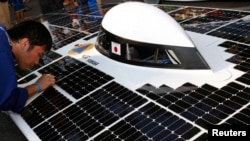SYDNEY —
One of the most punishing races for solar-powered cars has started today in northern Australia. The World Solar Challenge is a 3,000 kilometer trek through the Australia’s arid heart, from Darwin to Adelaide. Thirty-nine cars made the finals, including teams from the U.S., Saudi Arabia and Iran.
The race through Australia’s central desert brings together the world's most efficient prototype solar cars. The competition is, in effect, a giant research project to test the most modern technology in very harsh conditions. The teams will have to negotiate the unrelenting desert heat in cramped cabins, often with limited ventilation.
The only British entry, from Cambridge University, crashed during testing.
Chris Selwood, the organizer of the World Solar Challenge, says it has become a highly competitive international event.
“Twenty-six countries are coming, lots of different cultures. We’ve got people from Saudi Arabia; we’ve got people from Iran. We transcend those political divides. It’s all about bright young people not only dreaming of a cleaner, greener future, but working hard to make those dreams a reality,” says Selwood.
A team from the University of New South Wales in Sydney is competing in what engineers say could eventually be Australia's first practical solar-powered car. It looks like a regular vehicle and is a move away from previous designs that resembled a large table on three wheels.
The Australian vehicle is propelled by four square meters of silicon solar panels, which cover its roof and hood. They convert energy from the sun into electricity that drives two in-hub rear wheel electric motors. Power can also be stored in a bank of batteries, which gives the vehicle a range of 650 kilometers.
Sam Paterson, the project’s director, says it is an exciting step forward.
“This car takes solar cars in a completely new direction, really turns heads. It is something that is sleek and beautiful, and we’ve put a lot of design effort into it in terms of not just functionality but aesthetics and appeal to attract more attention, basically. And build something that is beautiful yet efficient,” says Paterson.
The race, which is held every two years, was first run in 1987. It is scheduled to end in the southern Australian city of Adelaide next Thursday. Conditions for the start were good, with clear skies and temperatures of 34 degrees Celsius. The defending champion is the 'Tokai' team from Japan.
The race through Australia’s central desert brings together the world's most efficient prototype solar cars. The competition is, in effect, a giant research project to test the most modern technology in very harsh conditions. The teams will have to negotiate the unrelenting desert heat in cramped cabins, often with limited ventilation.
The only British entry, from Cambridge University, crashed during testing.
Chris Selwood, the organizer of the World Solar Challenge, says it has become a highly competitive international event.
“Twenty-six countries are coming, lots of different cultures. We’ve got people from Saudi Arabia; we’ve got people from Iran. We transcend those political divides. It’s all about bright young people not only dreaming of a cleaner, greener future, but working hard to make those dreams a reality,” says Selwood.
A team from the University of New South Wales in Sydney is competing in what engineers say could eventually be Australia's first practical solar-powered car. It looks like a regular vehicle and is a move away from previous designs that resembled a large table on three wheels.
The Australian vehicle is propelled by four square meters of silicon solar panels, which cover its roof and hood. They convert energy from the sun into electricity that drives two in-hub rear wheel electric motors. Power can also be stored in a bank of batteries, which gives the vehicle a range of 650 kilometers.
Sam Paterson, the project’s director, says it is an exciting step forward.
“This car takes solar cars in a completely new direction, really turns heads. It is something that is sleek and beautiful, and we’ve put a lot of design effort into it in terms of not just functionality but aesthetics and appeal to attract more attention, basically. And build something that is beautiful yet efficient,” says Paterson.
The race, which is held every two years, was first run in 1987. It is scheduled to end in the southern Australian city of Adelaide next Thursday. Conditions for the start were good, with clear skies and temperatures of 34 degrees Celsius. The defending champion is the 'Tokai' team from Japan.





